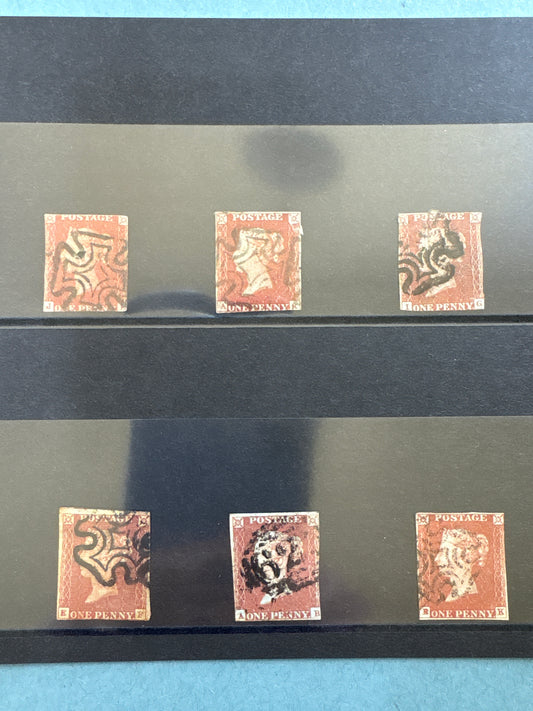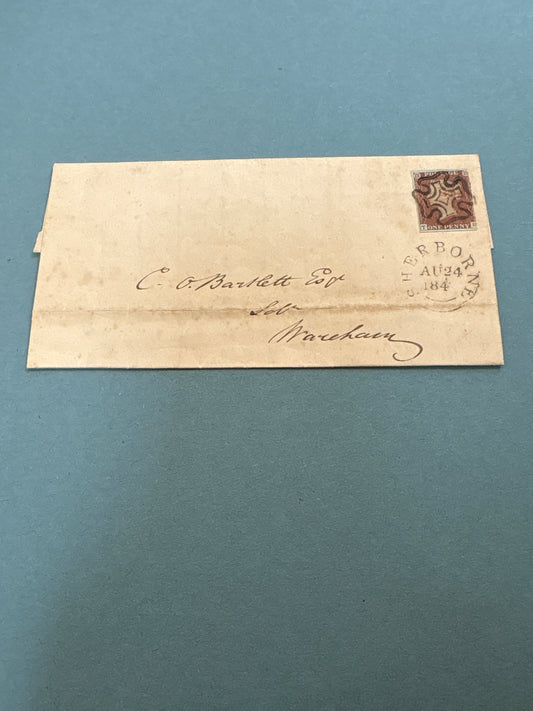Collection: Penny Blacks, Reds, 2d Blues
The Penny Black, Penny Red, and Two Penny Blue are three of the most iconic and historically significant postage stamps ever issued, each representing a pivotal moment in the evolution of the British postal system—and in many ways, the birth of modern postage.
The Penny Black holds the distinction of being the world’s first adhesive postage stamp used in a public postal system. Issued on 1 May 1840 in the United Kingdom (though not officially valid for use until 6 May), it featured a profile of Queen Victoria based on a sketch by William Wyon. The simplicity of its design—black ink on white paper—was both elegant and revolutionary. The idea behind the stamp was spearheaded by Sir Rowland Hill, whose reforms made mail delivery affordable and efficient for the general public. For just one penny, a letter weighing up to half an ounce could be sent anywhere within the UK. However, a practical flaw soon emerged: black ink made cancellation marks difficult to see, enabling people to reuse stamps illicitly. This shortcoming led to the stamp's retirement after only a year.
To resolve this issue, the Penny Red was introduced in 1841. The design remained largely the same, still featuring Queen Victoria's profile, but now printed in red-brown ink to allow for clearer cancellation marks using black ink. The stamp remained in circulation for nearly 40 years and became the mainstay of British postage throughout much of the Victorian era. While millions were printed, subtle differences in the plate numbers and lettering make certain editions highly collectible today. Its long production run and many variations offer a playground for philatelists who relish tracing its intricate details.
Issued at the same time as the Penny Black, the Two Penny Blue was its higher-value counterpart, used for heavier letters or parcels. It bore the same design and artistic influences as the Penny Black, even sharing the distinctive engraving by Charles Heath and punch work by Perkins Bacon & Co. What set it apart, of course, was the blue ink and its face value. Much like the Penny Black, it too faced issues with cancellation visibility, which were later corrected with colour and design tweaks. While not as well-known to the general public, the Two Penny Blue is highly esteemed among collectors for its rarity and early role in postage history.
Together, these three stamps represent a leap in communication, accessibility, and social reform. They transformed letter-writing from a costly luxury to an everyday act of connection, all while showcasing the elegance and innovation of Victorian design. Today, they stand not only as artifacts of postal history but also as cultural emblems—a testament to how a small square of paper can carry immense historical weight. Whether admired through a glass case in a museum or nestled in a collector’s album, these stamps continue to captivate with their enduring charm and significance.
-
Penny Red - 1967 Penny Red on Addressed Piece From Alford to London
Regular price £15.00 GBPRegular priceUnit price / per -
Penny Red - 6 x Penny Red Stamps mainly Maltese Cross Cancellations
Regular price £15.00 GBPRegular priceUnit price / per -
History - 1841 Penny Red Three Margin on Wrapper from Sherborne to Wareham
Regular price £30.00 GBPRegular priceUnit price / per


